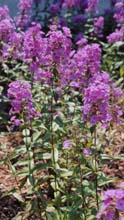
 |
| phlox (Phlox maculata cv 'Rosalind') Research and Collections Center, prairie garden |
Prairie remnants near and around unused fields, cemeteries, highways, and around protected preserves can be protected and preserved with the hope of expanding the prairie land later.
Small prairie gardens at home or at a school will attract butterflies, bees, and other insects, and provide a habitat for a few prairie plants.
Medium-size sites provide a more stable habitat that some species of birds and other animals can use. A larger site allows a greater diversity of prairie plants and animals to thrive.
Large sites contribute to the overall stability of the prairie ecosystem. They attract small mammals that add to the diversity of prairie life. If the site is large enough to include the watershed of a stream or several streams, the prairie can improve the water quality of the watershed. The roots of prairie plants help hold the soil in place and keep it from washing into streams.
|
|
Copyright © 2000 Illinois State Museum